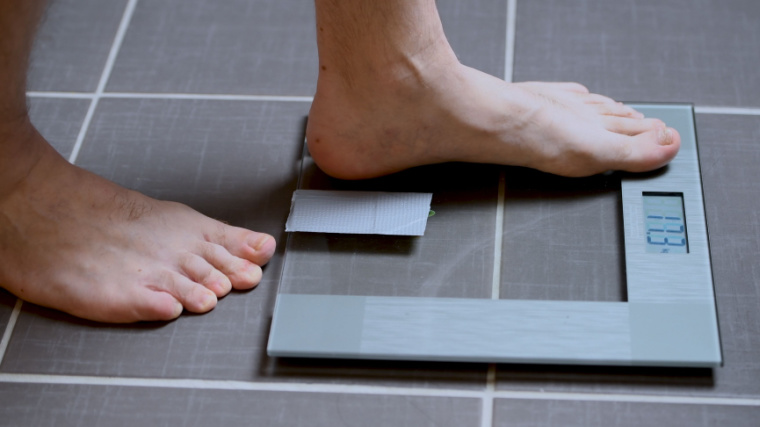
“Based on a 2,000 calorie diet.” If you’ve bought pre-packaged food in the past 25 years, you’ve probably seen a nutrition label with that phrase or something similar. Beginning in the mid-1990s, government regulations around the world began requiring food manufacturers to provide consumers with a basic nutritional breakdown of whatever they’re about to eat.
This information typically includes macronutrients like protein, carbohydrates, and fats; micronutrients like vitamins and minerals; and total calories. While the intention might’ve been good, it ended up potentially raising more questions than answers. One of the biggest questions being, why 2,000 calories?

The bad news is that the number was pulled from a survey of Americans more than 30 years ago and has managed to remain the default reference point. The good news is that, just a few years ago, labels in the US changed the phrasing to clarify, “2,000 calories a day is used for general nutrition advice.” It’s a better step, but it still doesn’t address the 2,000-dollar question.
Here’s a more useful guide to figuring out an individualized, effective calorie intake whether you’re a college rugby player looking to build some muscular armor, a hopeful vacationer who wants to hit the beach with six-pack abs, or a mother of three aiming to increase her deadlift.
How Many Calories
Nutrients vs. Calories
Every food can be a combination of three basic macronutrients — protein (which contains amino acids), carbohydrates (which covers complex carbs, fiber, and sugar), and fats (saturated and unsaturated). These nutrients are the composite building blocks of a food’s caloric payload.
On a per-gram basis, one gram of protein delivers four calories, one gram of carbohydrates also delivers four calories whether it’s complex, fiber, or sugar, and one gram of fat brings in a dense nine calories.
In terms of their effects on the body, protein is the only nutrient responsible for repairing and creating new muscle tissue. Carbohydrates and fats are, generally speaking, considered “energy providers” and can be burned by your body to fuel activity whether it’s walking, sprinting, lifting weights, or playing tennis.
While total daily/weekly calorie intake will determine any loss or gain in general body weight, the ratio of macronutrients will more specifically determine the change in lean muscle tissue and body fat.

In broad terms, nutrition plans that are relatively lower in protein will compromise muscle development, strength gains, and overall energy levels. (1) Meanwhile, eating plans that are relatively lower in carbohydrates and/or fats may or may not affect energy levels significantly, as long as you’re eating enough of the “other” energy source — low-carb diets can provide energy via a relatively high fat intake, while low-fat plans meet energy needs with ample carbs.
By manipulating these three macronutrients, you can not only adjust your overall calorie intake but, with strategic planning, you can maintain a given calorie level while fine-tuning the macronutrients to achieve particular goals.
For example, a 2,500-calorie diet which provides 250 grams of protein, 190 grams of carbohydrates, and 80 grams of fat will yield drastically different physique and performance results compared to the same person following a 2,500-calorie diet consisting of 50 grams of protein, 375 grams of carbs, and 90 grams of fat.
Adjusting your macros is an overlooked “diet hack” that can be used as an alternative to simply increasing or decreasing total calories. Matching both your calorie intake and your macronutrient profile to your specific goals will be the most effective approach.
Muscle-Building Calorie Goals
When it’s time to build muscle, many people focus on designing the most effective workout plan, but that’s only half the story. The right training stimulus will politely ask your body to build more muscle, but nutrition is what determines whether or not your body actually grants the request. Here’s how to literally and figuratively tip the scales in your favor.
Nutrient Targets
Your number one priority for adding muscle is getting enough of the only nutrient responsible for creating muscle tissue — protein. Aim to get a minimum of .74 grams of protein per pound of body weight (1.62 grams per kilogram). (2)
Because .74 is a seemingly random and mathematically tricky number to work with, rounding up to a long-touted “one gram per pound of body weight” is equally effective. Notably, higher protein intake is not directly associated with increased muscle growth. (2) Fortunately, excess calories from protein are less likely to be stored as body fat, so more protein may not necessarily help, but it certainly won’t hurt. (3)
After your target protein intake is determined, fill the caloric gap with a balance of carbohydrates depending largely on your activity level. Aim for two to three grams of carbohydrates per pound of bodyweight (4.5 to 6.5 grams per kilogram), with relatively high volume and/or high frequency training calling for an appropriately higher carb intake to fuel performance and recovery. (4)
Fat intake can complete the remaining calorie balance. For optimal health, immune system function, and overall recovery, fats should ideally provide at least 25% of the total daily calories. (5) This intake can be nudged higher toward 30 to 35% of daily calories as long as you accommodate by reducing either carbohydrates or protein.
Because fats are much more calorically dense than protein and carbs, a little goes a long way, so make adjustments on a small scale.
Calorie Guidelines
Setting your macronutrients in place will naturally end up providing a caloric total, but you need to ensure it’s still enough calories to support muscle growth. Just be sure to find the line between “enough” and “too much.” When it’s time to eat for size, it’s all too easy to cross into full-blown gorging territory.
When it comes to increasing your calories, there’s a point where more isn’t better because your body can slide right past muscle gains and end up creating only body fat. If you’re currently tracking your calorie intake, you can promote muscle gain by adding 350 to 500 calories per day. (6)

That relatively small increase could be as simple as adding a basic afternoon snack, like a small turkey and cheese sandwich with a piece of fruit or a single serving of a high-quality mass gainer shake, to your current daily diet.
If you’re not currently tracking your calories, give yourself a starting calorie intake equal to your current body weight x 20. So, if you currently weigh 180 pounds, aim for 3,600 calories per day. Of that, you’ll apply the macronutrient targets previously listed: 180 grams of protein, 270 grams of carbs, and 80 grams of fat.
Here’s the tricky part: the macro targets in this example only tally up to 2,520 calories, so you’d actually fall short of your intended calories. Fill in the difference primarily from protein sources to potentially reduce fat gain, but include a combination of carbohydrates and fats to make the plan simpler and more practical to implement.
Be sure to hit the target every day, not just on training days. You’re still recovering and growing on rest days, so don’t reduce your meals just because you’re not working out.
How to Adjust
For maximum results, you need to fine-tune your nutrition plan as you go along depending on the results you see. You can’t simply follow one rigid plan for weeks or months on end without adjustment and expect great results.
It’d be like trying to drive down a highway without ever changing lanes — you’re going to be miserable the entire time and you still probably won’t end up where you want to be. Instead, track your muscle gain results by monitoring your strength in the gym. You should be steadily progressing in performance (more weight and/or more repetitions each week). Having better workouts is a clue that you’re recovering well and feeding your body enough nutrients.
Most notably, monitor your body weight each week and expect gains of roughly two to four pounds per month. Yes, per month. (7) That’s about as much muscle tissue as the body can build in that timeframe. Gaining significant body weight faster is an indicator that you’re likely creating more body fat than lean muscle tissue.
However, variables such as your age and overall training experience can be factors that determine your individual rate of muscle gains. Lifters relatively new to the gym typically gain more muscle, more quickly, while veteran lifters take more time to respond to the muscle-building stimulus with new muscle mass.
If the scale doesn’t increase in two to three weeks, add roughly 250 calories per day and continue monitoring. Repeat as needed, being aware that cooking and chewing are as important as lifting when it comes to adding size.
Calorie Deficit for Fat Loss
The words “fat loss diet” have sent countless shivers down countless spines over the years. Fad diets based on extreme and unsustainable behaviors are largely to blame. These unrealistic, niche plans have become so commonplace that they’re often considered the standard way of reshaping your physique.
Fortunately, you can skip over the fads and rely on time-tested nutrition principles to support your fat loss goals. No gimmicks necessary. While diet plans to build muscle are all generally similar (eat plenty of calories and don’t skimp on the protein), fat loss diet plans can vary in nutrient breakdown without significantly compromising results.
Nutrient Targets
Fat loss diet plans typically come in two primary flavors, no pun intended. Diets can either be relatively low carb or relatively low fat. Both have been shown to be equally effective, so it’s essentially a matter of which can best suit your individual preferences, while also supporting your overall training plan. (8)
In a relatively low carb diet, carbohydrates typically provide no more than 25% of your daily calories. This includes carbs from all sources — complex carbs, sugars, and fiber. Contrary to some carb-focused nutrition influencers, “net carbs” (the carbohydrate number after fiber is subtracted) isn’t really a thing. It’s a term that has more to do with food-product marketing than actually nutrition.

Some low-carb dieters take this approach to an extreme by adopting a ketogenic diet, or extremely low-carb dieting (typically less than 50 grams of carbohydrates per day). While keto diets can spur quick weight loss initially, it’s been shown to not deliver significantly better results than other alternatives, while also being notably difficult to adhere to. (9)
In a relatively low fat diet, fats deliver less than 25% of your total calories each day. Because each gram of fat carries nine calories, reducing fat sources in your diet is a quick and efficient way to reduce your total calories.
However, fats are essential for your body’s natural function and they play a role in everything from supporting a strong immune system to general hormone function. (10) Keeping your fat intake too low for too long can potentially lead to health issues, so be aware of possible issues if following this approach.
In either plan, protein intake should remain a priority. Maintaining high protein levels has been shown to support fat loss, encourage muscle preservation, and improve overall body composition. (11)
Calorie Guidelines
Significant fat loss can’t happen without a caloric deficit. If you’re not burning more calories than you take in, you won’t see any major progress. While some misguided dieters take this advice to the extreme by severely restricting calories, drastically increasing their calorie expenditure through excessive exercise, or doing both, a more moderate approach will yield better overall results.
Follow a well-designed training plan, incorporating both resistance training for muscle preservation and cardiovascular exercise for overall health, improved recovery, and moderately increased calorie expenditure. Pair that training with a nutrition plan that provides slightly restricted calories.
If you’re currently tracking your calories, decrease each day’s intake by 500 to 750 calories. (12) Focus on primarily reducing either your carbohydrate or fat sources, while keeping your protein levels relatively high.
If you’re not currently tracking calories, aim to take in your current body weight x 12 in total calories. For example, if you currently weigh 195 pounds, set your daily calorie goal at roughly 2,300 calories.
One popular, however inefficient, approach is to “eat for the body you want,” or set calorie intake using your “goal weight.” Not only does this technique rely on guesstimating your future self’s body weight, which may or may not end up accurate, but it provides your current self with insufficient calories to fuel training and recovery. Instead, stay in the present and feed the body you’re working with.
Whether you choose to follow a lower carb or lower fat plan can come down to individual preference and overall training style — if you have a high volume of training, lifting five days per week with several additional cardio sessions, you may perform and recover better with a lower fat plan which allows relatively higher carb intake to fuel intense workouts.
How to Adjust
It’s important to differentiate between fat loss (reduced body fat) and weight loss (reduced body weight). Anyone who’s endured an outdoor adventure and ended up drenched in sweat has experienced “weight loss.” It’s transient, almost always from water loss, and it’s regained almost immediately. More drastically, bed-ridden patients under long-term medical care also experience “weight loss” as muscle tissue wastes away.
When most people set a goal of losing weight, they (hopefully) mean to specify fat loss — reducing stored body fat to create a healthier and more aesthetic physique. For that reason, it’s important not to overfocus on just reducing your body weight (making the scale read a progressively lower number) during a fat loss plan.

The scale should, typically, trend down over the course of weeks or months, but body recomposition (the addition of lean muscle while reducing body fat) can make progress on the scale unreliable, at best.
Consider also relying on more tangible criteria such as your performance in the gym (weight lifted, reps performed, and general energy during training), as well as objective measures like the fit of your clothes or tape measurements of key body parts like your thighs, upper arms, or waist.
Losing two pounds of body weight per week while also improving other metrics would be considered excellent progress. Dropping one pound per week while improving the other benchmarks is also an effective and sustainable rate of progress. Variables that can sometimes lead to faster short-term results would include having a relatively larger starting point or following a very low carb diet plan.
If you’re not seeing weekly results with objective measures (gym performance and clothes/measurements) and scale weight, you can either reduce your calories by 150 to 200 per day or manipulate your macronutrient intake while keeping overall calories the same, such as decreasing carbs while increasing protein or fat.
Even though restricting calories is necessary for fat loss, it’s important to not reduce your intake too low. (13) To avoid “stalling out” and sending your body into panic mode (where fat loss ceases regardless of calorie reduction), avoid reducing calories below your current body weight x 10. To continue safely and effectively performing regular training while supporting general health, consider this limit the “do not cross”-zone.
Eat for Strength and Recovery
Physique-based goals aren’t the only time you should pay attention to nutrition. For optimal performance and long-term results, even lifters who prioritize their PRs over their arm size or ab development can benefit from targeted nutrition practices. The right diet plan will fuel strength-focused workouts while also delivering much needed nutrients for recovery between sessions. (14)
For the most part, a nutrition plan that supports strength gains and one that supports muscle gains will appear fairly similar because the two goals are closely related. One of the most counterproductive approaches, however, is to “train for strength while eating for fat loss.” Restricting your energy intake while asking your body for high-performance output will only lead to poor progress on both fronts.
Nutrient Targets
Protein is essential for muscle growth as well as repair, so keeping the one-gram-per-pound target in sight is (still) the best approach. Even if you’re not interested in building wide lats or massive quads, you’ll appreciate the muscle-sparing benefits of a high protein intake once you notice reduced post-workout muscle soreness.
Carbohydrate intake can be up to three grams per pound of body weight per day. (15) This will allow optimal performance during high volume and/or high frequency training. While it’s technically possible to train with high intensity on a relatively lower carb intake, it’s fitting a square peg in a round nutritional hole.

The body’s innate physiological preference is to fuel intense activity, like hard training, with carbs. Investing time and energy into “retraining” your body to burn dietary fats for energy will compromise short-term progress for minimal, if any, long-term benefit.
Aim for 30% of your daily calories from fats. This range should support overall health, hormonal function, metabolism, immune system benefit, and general recovery. (16) A relatively higher percentage of dietary fats will also help to avoid a calorie deficit, which would significantly impact training results.
Calorie Guidelines
When your goal isn’t to specifically add muscle or reduce body fat, your overall calorie intake doesn’t need to be excessive as long as it provides the target nutrients. Set a daily calorie target of your current body weight x 15. So, if you weigh 210 pounds, aim for roughly 3,100 to 3,200 calories per day with enough protein, carbs, and fats. If you’re 130 pounds, you’re looking at around 1,900 calories each day.
As with the muscle-building nutrition plan, keep your daily calories the same whether it’s a training day or a rest day. This will allow you to recover from your most recent workout while also preparing to fuel your upcoming training session.
Some lifters may instinctively eat less on days they don’t train, either due to a reduced appetite or the thought that they’re not “putting the calories to use.” However, the body is still repairing and recovering from previous training, so restricting calories is inefficient.
What you could do, however, to adjust your diet plan without compromising results is to steal a page from the fat loss playbook and manipulate your macronutrients on rest days. Consider decreasing carb intake while increasing protein and fats, to maintain the same total calorie intake. This can support recovery while potentially minimizing fat gain, if you’re into that sort of thing.
How to Adjust
When your goal is to hit PRs, performance in the gym is the number one priority. Your nutrition plan should allow you to step into the gym feeling ready to attack each session with full energy and minimal residual soreness from the previous workout.
Weights and repetitions should move steadily upward in each workout throughout the week. While strength plateaus are a natural occurrence in any training plan, they should be relatively few and far between when a well-designed training routine is supported by strategic nutrition.
Your body weight may hold steady or increase slightly over time, roughly one pound per week, which is an indicator that your calorie intake is sufficient. If you’re losing body weight consistently, increase your daily plan by 250 calories.
Some lifters consider changing their nutrition around the most challenging session of their training week (typically a brutal leg day) by going above and beyond their calorie target prior to the workout. The usual thinking is that they can supercompensate or “overfuel” themselves into having an incredibly productive workout.
However, if your consistent nutrition provides ample macronutrients and calories, there’s little physical benefit to having an epic gorge the day before (or morning of) an extra-intense workout.
You might find some psychological benefit from believing those extra pancakes will add reps to your squat, but unless you’ve been inadvertently restricting your nutrition or not hitting your daily target, it’s not going to help.
Kitchen Beats Gym
You hopefully wouldn’t show up at work every day, put in your eight or nine hours, and then forget to cash your paycheck at the end of the week. If you did, then all that hard work was for nothing and you never actually reap the benefits. That’s exactly what so many lifters do when they overemphasize their training program while giving bare-minimum attention to their nutrition. Instead, set yourself up for success by following the kind of eating plan that lets you cash in on all that in-gym effort.
References
- Nunes, E. A., Colenso-Semple, L., McKellar, S. R., Yau, T., Ali, M. U., Fitzpatrick-Lewis, D., Sherifali, D., Gaudichon, C., Tomé, D., Atherton, P. J., Robles, M. C., Naranjo-Modad, S., Braun, M., Landi, F., and Phillips, S. M. (2022) Systematic review and meta-analysis of protein intake to support muscle mass and function in healthy adults, Journal of Cachexia, Sarcopenia and Muscle, 13, 795–810, https://doi.org/10.1002/jcsm.12922
- Morton, R. W., Murphy, K. T., McKellar, S. R., Schoenfeld, B. J., Henselmans, M., Helms, E., Aragon, A. A., Devries, M. C., Banfield, L., Krieger, J. W., & Phillips, S. M. (2018). A systematic review, meta-analysis and meta-regression of the effect of protein supplementation on resistance training-induced gains in muscle mass and strength in healthy adults. British journal of sports medicine, 52(6), 376–384. https://doi.org/10.1136/bjsports-2017-097608
- Leaf, A., & Antonio, J. (2017). The Effects of Overfeeding on Body Composition: The Role of Macronutrient Composition – A Narrative Review. International journal of exercise science, 10(8), 1275–1296.
- Richard B Kreider, Colin D Wilborn, Lem Taylor, Bill Campbell, Anthony L Almada, Rick Collins, Mathew Cooke, Conrad P Earnest, Mike Greenwood, Douglas S Kalman, Chad M Kerksick, Susan M Kleiner, Brian Leutholtz, Hector Lopez, Lonnie M Lowery, Ron Mendel, Abbie Smith, Marie Spano, Robert Wildman, Darryn S Willoughby, Tim N Ziegenfuss & Jose Antonio (2010) ISSN exercise & sport nutrition review: research & recommendations, Journal of the International Society of Sports Nutrition, 7:1, DOI: 10.1186/1550-2783-7-7
- Economos, C.D., Bortz, S.S. & Nelson, M.E. Nutritional Practices of Elite Athletes. Sports Medicine 16, 381–399 (1993). https://doi.org/10.2165/00007256-199316060-00004
- Slater, G. J., Dieter, B. P., Marsh, D. J., Helms, E. R., Shaw, G., & Iraki, J. (2019). Is an Energy Surplus Required to Maximize Skeletal Muscle Hypertrophy Associated With Resistance Training. Frontiers in nutrition, 6, 131. https://doi.org/10.3389/fnut.2019.00131
- Morton, R. W., Murphy, K. T., McKellar, S. R., Schoenfeld, B. J., Henselmans, M., Helms, E., Aragon, A. A., Devries, M. C., Banfield, L., Krieger, J. W., & Phillips, S. M. (2018). A systematic review, meta-analysis and meta-regression of the effect of protein supplementation on resistance training-induced gains in muscle mass and strength in healthy adults. British journal of sports medicine, 52(6), 376–384. https://doi.org/10.1136/bjsports-2017-097608
- Gardner, C. D., Trepanowski, J. F., Del Gobbo, L. C., Hauser, M. E., Rigdon, J., Ioannidis, J. P. A., Desai, M., & King, A. C. (2018). Effect of Low-Fat vs Low-Carbohydrate Diet on 12-Month Weight Loss in Overweight Adults and the Association With Genotype Pattern or Insulin Secretion: The DIETFITS Randomized Clinical Trial. JAMA, 319(7), 667–679. https://doi.org/10.1001/jama.2018.0245
- Kirkpatrick, C. F., Bolick, J. P., Kris-Etherton, P. M., Sikand, G., Aspry, K. E., Soffer, D. E., Willard, K. E., & Maki, K. C. (2019). Review of current evidence and clinical recommendations on the effects of low-carbohydrate and very-low-carbohydrate (including ketogenic) diets for the management of body weight and other cardiometabolic risk factors: A scientific statement from the National Lipid Association Nutrition and Lifestyle Task Force. Journal of clinical lipidology, 13(5), 689–711.e1. https://doi.org/10.1016/j.jacl.2019.08.003
- Venkatraman JT, Leddy J, Pendergast D. Dietary fats and immune status in athletes: clinical implications. Medicine and Science in Sports and Exercise. 2000 Jul;32(7 Suppl):S389-95. DOI: 10.1097/00005768-200007001-00003. PMID: 10910295.
- Moon, J., & Koh, G. (2020). Clinical Evidence and Mechanisms of High-Protein Diet-Induced Weight Loss. Journal of obesity & metabolic syndrome, 29(3), 166–173. https://doi.org/10.7570/jomes20028
- Kim J. Y. (2021). Optimal Diet Strategies for Weight Loss and Weight Loss Maintenance. Journal of obesity & metabolic syndrome, 30(1), 20–31. https://doi.org/10.7570/jomes20065
- Rosenbaum, M., & Leibel, R. L. (2010). Adaptive thermogenesis in humans. International journal of obesity (2005), 34 Suppl 1(0 1), S47–S55. https://doi.org/10.1038/ijo.2010.184
- Gary Slater & Stuart M. Phillips (2011) Nutrition guidelines for strength sports: Sprinting, weightlifting, throwing events, and bodybuilding, Journal of Sports Sciences, 29:sup1, S67-S77, DOI: 10.1080/02640414.2011.574722
- Kanter M. (2018). High-Quality Carbohydrates and Physical Performance: Expert Panel Report. Nutrition today, 53(1), 35–39. https://doi.org/10.1097/NT.0000000000000238
- Lowery L. M. (2004). Dietary fat and sports nutrition: a primer. Journal of sports science & medicine, 3(3), 106–117.
Featured Image: Drazen Zigic / Shutterstock






